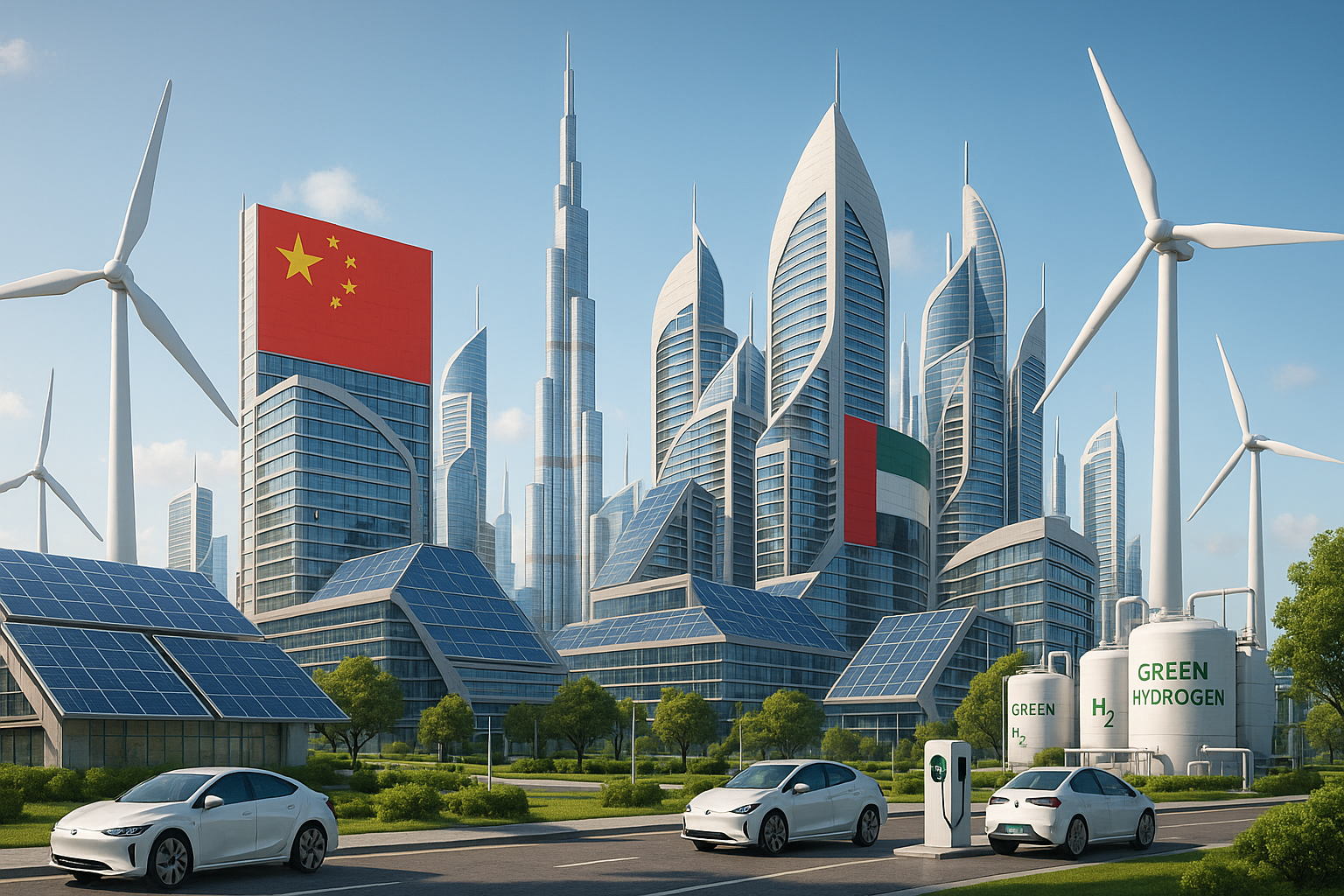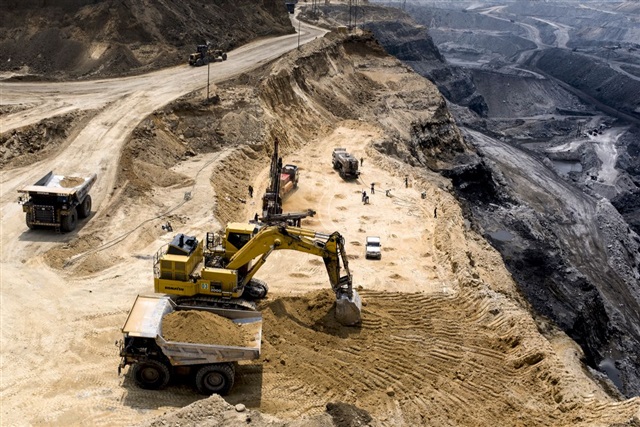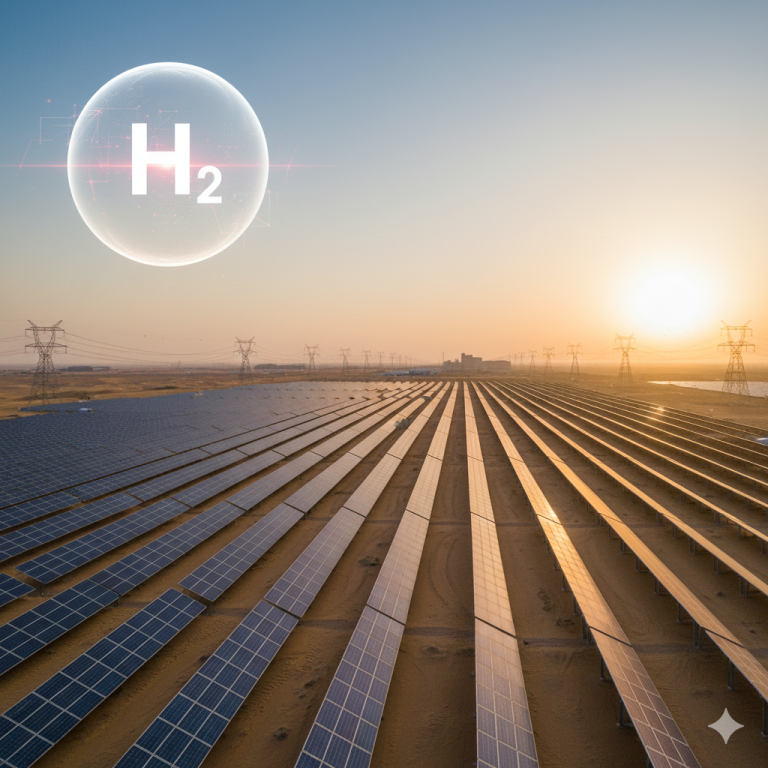The Green Dividend: Jobs, Growth, and Diversification
In an era defined by profound geopolitical shifts, rapid technological acceleration, and the undeniable, urgent imperative of global climate action, the burgeoning energy partnership between the People’s Republic of China and the United Arab Emirates (UAE) stands as a compelling and exemplary testament to the transformative power of strategic collaboration. Far from a mere transactional relationship focused solely on traditional energy resources, this alliance has evolved into a comprehensive strategic partnership, yielding a significant and multifaceted “green dividend.” This dividend manifests not only in tangible economic benefits such as robust job creation and sustained economic growth but also in a profound and strategic diversification away from traditional hydrocarbon dependence, paving the way for a more resilient and sustainable future. This article delves into the intricate industrial perspective, meticulously traces the historical trajectory, and illuminates the promising future potential of this pivotal cooperation, illustrating with empirical evidence and strategic insights how it is fundamentally reshaping the global energy landscape and fostering sustainable prosperity for both nations, while also offering a blueprint for international cooperation in the 21st century. The narrative unfolds against a backdrop of global energy transition, where the synergy between China’s industrial might and the UAE’s visionary leadership creates a powerful force for change.
A Foundation of Strategic Partnership: From Hydrocarbons to a Green Horizon
The relationship between China and the UAE has undergone a remarkable transformation and deepening over the past decade. What began as a nascent economic engagement culminated in the establishment of a strategic partnership in 2012, which was subsequently elevated to a comprehensive strategic partnership in 2018. This elevated status is not merely diplomatic rhetoric; it reflects a profound convergence of national interests and a shared vision for long-term economic development, regional stability, and global sustainability. This partnership is underpinned by a pragmatic and forward-looking approach to energy security and environmental stewardship.
The economic ties between these two nations are not just substantial; they are dynamic and expanding. Total bilateral trade impressively exceeded $100 billion in 2024, representing a healthy and consistent 7% year-on-year growth. More indicative of the strategic shift, however, is the performance of non-oil trade, which witnessed an even more impressive 18% growth in the first quarter of 2025. This robust growth in non-oil sectors is a clear and unequivocal signal of a deliberate, successful, and accelerating diversification effort by the UAE, actively supported by Chinese investment and expertise.
Historically, the bedrock of this cooperation was firmly rooted in the traditional oil and gas sector. The enduring partnership between China National Petroleum Corporation (CNPC) and Abu Dhabi National Oil Company (ADNOC) dates back to 2007, and has since expanded significantly in scope and depth. Key milestones in this foundational phase include:
Al Yasat Project (2013): This marked a pivotal moment as the first joint venture between ADNOC (holding a 60% stake) and CNPC (with 40%), signifying a substantial step into upstream collaboration and shared resource development.
North-East Bab Fields (2017): In a demonstration of increasing trust and operational integration, CNPC assumed a leadership role as an asset leader for an onshore oil concession, bringing its extensive operational experience to bear.
Offshore Fields (2018): The scope of cooperation further extended to critical offshore fields, including Umm Shaif & Nasr and Lower Zakum. This expansion further solidified China’s integral role in the UAE’s hydrocarbon production capabilities, ensuring energy supply security for China and revenue stability for the UAE.
Strategic Agreement (2024): A landmark comprehensive agreement was signed, encompassing the entire oil and gas industry chain. This extends from exploration and production to refining, petrochemicals, and distribution, underscoring the long-term, holistic commitment of both parties to a mutually beneficial energy future.
However, while traditional energy remains an indispensable cornerstone of their economic relationship, the overarching narrative has increasingly and decisively shifted towards green energy. This evolution is far more than a mere reactive response to escalating global climate pressures; it represents a proactive, visionary strategy designed to unlock entirely new avenues of economic growth, foster technological innovation, and ensure long-term energy security in a rapidly changing world. The UAE, blessed with abundant solar resources and guided by a visionary strategic outlook, has rapidly emerged as a fertile ground for Chinese investment, advanced technology, and specialized expertise in the burgeoning renewable energy sector.
Powering the Future: Green Energy Initiatives and Transformative Industrial Impact
The UAE’s commitment to a greener economy is not merely aspirational; it is demonstrably evident in a series of landmark projects and strategic investments that are reshaping its energy matrix. The nation has made truly significant strides in augmenting its renewable energy capacity, which recorded an impressive 21% increase between 2021 and 2023. This remarkable growth is directly attributable to ambitious, large-scale projects, many of which are characterized by deep involvement and collaboration with Chinese partners:
Noor Abu Dhabi: Standing as the world’s largest single-site solar installation with an installed capacity of 1.2 GW, Noor Abu Dhabi is a powerful symbol of the UAE’s audacious renewable energy ambitions. While its development involved a consortium of international partners, its sheer scale and operational success have set a global benchmark and provided invaluable experience for subsequent large-scale solar developments, many of which have seen significant Chinese participation.
Al Dhafra Solar PV Plant: This monumental project, currently under development and partially operational, is being built by the China Machinery Engineering Corporation (CMEC). Spanning an astonishing 21 square kilometers, it is poised to become one of the world’s largest single-site solar photovoltaic power plants. This project epitomizes the scale, ambition, and deep technological collaboration inherent in China-UAE partnerships in renewable energy infrastructure, showcasing Chinese engineering prowess and project management efficiency.
UAE Wind Power Demonstration Project: Completed by the Power Construction Corporation of China (PowerChina) in May 2023, this pioneering project marks the UAE’s strategic foray into wind energy. It represents a crucial step in diversifying its renewable energy portfolio beyond solar, with Chinese technological support proving instrumental in its successful implementation and operation.
Three Gorges Acquisition: In a significant strategic move, China’s state-owned Three Gorges Corporation, a global leader in clean energy, acquired a substantial stake in the UAE-based Alcazar Energy Partners. This acquisition is not merely a financial transaction; it significantly expands Chinese presence and influence in the Middle East’s rapidly growing renewable energy sector. More importantly, it facilitates crucial knowledge transfer, fosters technological exchange, and channels further investment into sustainable energy projects across the region.
These projects transcend mere statistics of megawatts generated or capital invested. They represent a fundamental and irreversible shift in industrial strategy and national economic planning. The active involvement of leading Chinese companies brings to the table not only substantial capital investment but also cutting-edge advanced technology, unparalleled engineering expertise, and highly efficient project execution capabilities. This powerful industrial synergy is acting as a potent catalyst, dramatically accelerating the UAE’s energy transition and firmly establishing it as a regional and increasingly global leader in renewable energy deployment and innovation. The transfer of best practices and technological know-how is creating a virtuous cycle of development.
The Green Dividend: Quantifying Jobs, Growth, and Strategic Diversification
The economic benefits accruing from this strategic green energy pivot are not merely theoretical; they are substantial, empirically quantifiable, and are collectively creating a tangible and enduring “green dividend” for the UAE, profoundly impacting its socio-economic fabric.
Robust Job Creation and Human Capital Development
The burgeoning green energy sector has rapidly emerged as a significant and dynamic engine for employment across the UAE. Over the past 18 months alone, a remarkable figure of more than 10,000 new green jobs have been created. These roles are incredibly diverse, spanning a wide spectrum of skills and expertise. They include highly specialized engineers and skilled technicians involved in the intricate design, construction, and ongoing maintenance of vast solar and wind farms. Beyond the physical infrastructure, there is a growing demand for researchers and developers pushing the boundaries of renewable energy technologies, as well as a myriad of professionals in related manufacturing, supply chain, and service industries. This significant influx of specialized, high-value jobs is contributing directly to the development of a more skilled, technologically adept, and diversified national workforce, thereby strategically reducing the nation’s historical reliance on traditional sectors and expatriate labor. Furthermore, this focus on green jobs often comes with significant investment in training and education, fostering a new generation of Emirati talent equipped for the future economy. This includes vocational training programs, university collaborations, and on-the-job skill development, all aimed at building a sustainable human capital base.
Accelerated Economic Growth and Investment Magnetism
The substantial investment flowing into green energy projects is not just a cost; it is a powerful stimulant fueling robust and sustainable economic growth. The UAE has proactively committed an impressive $1.2 billion to new solar projects, a figure that forms part of an even larger expected $150 billion in Middle Eastern green energy investments projected by 2025. This massive injection of capital into the economy stimulates local industries, fosters innovation, and significantly enhances the UAE’s attractiveness for further foreign direct investment. The sustained growth in non-oil trade, particularly the striking 18% increase observed in Q1 2025, serves as a clear and compelling indicator that the nation’s ambitious diversification efforts are indeed bearing substantial fruit, with green industries playing an increasingly central and prominent role in its economic future. This investment magnetism extends beyond direct project funding, drawing in ancillary services, technology providers, and research institutions, creating a vibrant ecosystem of innovation and economic activity.
Strategic Diversification and Environmental Stewardship
For the UAE, the strategic green energy partnership with China is not merely an opportunistic venture; it is a foundational cornerstone of its overarching economic diversification strategy. By assiduously developing a strong, resilient, and technologically advanced renewable energy sector, the UAE is systematically reducing its economic vulnerability to the inherent volatility and fluctuations in global oil prices. Simultaneously, it is strategically positioning itself as a leading regional and international hub for future energy technologies and sustainable development. This forward-thinking strategy is in perfect alignment with the nation’s long-term vision to construct a knowledge-based, innovation-driven, and environmentally sustainable economy. The measurable decline of 15% in the UAE’s energy sector emissions since 2022 further unequivocally underscores the profound environmental and economic benefits directly attributable to this strategic and timely shift. This dual benefit of economic resilience and environmental stewardship positions the UAE as a responsible global actor and a leader in the transition to a low-carbon future.
The Belt and Road Initiative: A Powerful Catalyst for Green Cooperation and Regional Integration
China’s ambitious Belt and Road Initiative (BRI) serves as an exceptionally powerful and expansive framework that has significantly facilitated and deepened this energy cooperation. The UAE, by virtue of its unique geographical location and its world-class infrastructure, including state-of-the-art ports, international airports, and sophisticated logistics networks, is strategically positioned as an indispensable BRI hub. This strategic positioning allows it to efficiently facilitate and optimize trade and investment flows between the East and the West, acting as a crucial nexus in the global supply chain. In 2024, BRI engagement witnessed an impressive $70.7 billion in new contracts and $51 billion in direct investments globally, with a substantial and growing green energy component accounting for $11.8 billion of this total. This clearly highlights the BRI’s increasingly vital role in channeling Chinese capital, advanced technology, and specialized expertise into sustainable development projects across the globe, with the UAE emerging as a prime and strategic beneficiary.
Within the expansive context of the BRI, the China-UAE energy partnership extends far beyond mere bilateral projects; it possesses significant regional influence and demonstrative power. The UAE’s remarkable success in rapidly developing its green energy sector, robustly supported by Chinese collaboration, is now serving as an inspiring and replicable model for other nations situated along the Belt and Road. This successful paradigm actively promotes sustainable development, fosters technological transfer, and encourages green investment across the broader region, thereby contributing to a more sustainable and interconnected global economy. This regional leadership amplifies the impact of the green dividend, creating a ripple effect of positive change across Asia and Africa.
Future Outlook: Sustaining the Momentum and Pioneering New Frontiers
The future trajectory of China-UAE energy cooperation appears exceptionally bright, poised for sustained growth, profound innovation, and the exploration of entirely new frontiers. The strategic alignment of China’s formidable technological prowess and its vast investment capacity with the UAE’s ambitious economic diversification goals and its abundant natural renewable resources creates an incredibly powerful and synergistic relationship. This synergy is expected to drive further advancements and mutual benefits. Key areas identified for future development and intensified collaboration include:
Advanced Renewable Technologies: There is immense potential for further collaboration in cutting-edge solar technologies, such as advanced concentrated solar power (CSP) systems, next-generation perovskite solar cells, and highly efficient bifacial modules. Additionally, joint efforts in developing and deploying advanced energy storage solutions (e.g., grid-scale batteries, pumped hydro storage, and advanced flow batteries) and smart grid infrastructure will be crucial for grid stability, reliability, and the seamless integration of intermittent renewable sources. This includes the development of AI-powered grid management systems to optimize energy flow and predict demand, ensuring a resilient and efficient energy supply.
Green Hydrogen Economy: The UAE possesses unparalleled potential to emerge as a global leader in green hydrogen production, leveraging its abundant and cost-effective solar resources. Chinese partners can play a pivotal role by providing advanced electrolysis technologies, engineering expertise for large-scale production facilities, and crucial market access for the nascent green hydrogen economy. This collaboration could position both nations at the forefront of a new energy paradigm, offering a clean fuel source for heavy industry, transportation, and power generation, thereby significantly reducing carbon footprints globally and contributing to a circular economy.
Carbon Capture, Utilization, and Storage (CCUS): Recognizing the continued importance of existing industrial processes, there is significant scope for joint research, development, and large-scale deployment of Carbon Capture, Utilization, and Storage (CCUS) technologies. These technologies are vital for decarbonizing hard-to-abate industrial sectors, particularly within the oil and gas industry, and for achieving net-zero emissions targets. Collaboration could focus on enhancing efficiency, reducing costs, and exploring innovative utilization pathways for captured carbon, turning a waste product into a valuable resource and fostering industrial symbiosis.
Digitalization of Energy Systems: Cooperation in applying advanced digital technologies, including artificial intelligence (AI), machine learning, big data analytics, and the Internet of Things (IoT), will be instrumental in optimizing energy production, enhancing the efficiency of distribution networks, and intelligently managing energy consumption across various sectors. This will lead to more resilient, efficient, and sustainable energy systems, capable of responding dynamically to demand fluctuations and integrating diverse energy sources, ultimately creating a smarter and more responsive energy grid.
Research and Development Hubs: Establishing joint research and development centers focused on renewable energy innovation, energy efficiency, and sustainable technologies could foster a vibrant ecosystem of innovation, attracting global talent and accelerating breakthroughs. These hubs could become incubators for new startups and a platform for academic-industrial collaboration, driving the next wave of green technological advancements and securing intellectual property for both nations.
Capacity Building and Talent Exchange: Expanding programs for talent exchange, vocational training, and academic collaboration will ensure a skilled workforce capable of driving the green energy transition. This includes scholarships, joint degree programs, professional development initiatives, and cultural exchange programs that foster mutual understanding and shared expertise. Investing in human capital is paramount for sustaining long-term growth in the green economy and ensuring local ownership of technological advancements.
Standardization and Policy Harmonization: As both nations become leaders in green energy, there is an opportunity to collaborate on developing international standards for renewable energy technologies, green hydrogen, and carbon accounting. Harmonizing policies and regulatory frameworks can facilitate cross-border investment and accelerate the global energy transition, creating a more predictable and attractive environment for green investments.
The consistently positive tone and robust nature of this partnership are not merely coincidental; they are the direct result of deep mutual respect, a clear understanding of shared economic interests, and a collective, forward-looking vision for a sustainable future. Both China and the UAE unequivocally recognize that sustainable development is not merely an environmental imperative but, more profoundly, a monumental economic opportunity. The substantial “green dividend” generated by their exemplary collaboration—manifesting tangibly in new jobs, accelerated economic growth, and strategic diversification—serves as a powerful and inspiring model for effective international cooperation in the complex and interconnected 21st century.
Conclusion
The China-UAE energy partnership, initially forged and strengthened within the traditional hydrocarbon sector, has successfully and strategically pivoted towards a robust, dynamic, and increasingly comprehensive collaboration in green energy. This remarkable evolution has not only profoundly strengthened bilateral ties and fostered deeper diplomatic relations but has also delivered a tangible and transformative “green dividend” for the UAE. This dividend is characterized by significant and sustained job creation across new industries, accelerated and diversified economic growth, and a successful, deliberate strategic diversification away from an over-reliance on oil. With the expansive Belt and Road Initiative providing a powerful strategic framework and a shared, unwavering commitment to innovation and sustainability, the future of this partnership promises even greater dividends. It is poised to further cement its role as a leading beacon of sustainable development, a model of effective strategic cooperation, and a catalyst for green prosperity on the global stage, demonstrating how nations can collaboratively address global challenges while simultaneously pursuing national development objectives. The enduring legacy of this partnership will be a testament to how strategic foresight, mutual trust, and collaborative action can transform economic landscapes, contribute significantly to global environmental stewardship, and build a more resilient and prosperous future for all involved. This is the true essence of the green dividend: a sustainable future built on shared vision and collective effort, a future where economic prosperity and environmental responsibility are not mutually exclusive but intrinsically linked and mutually reinforcing.







